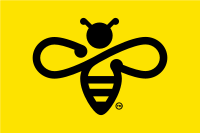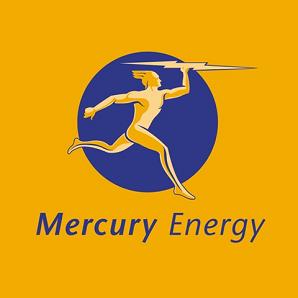Mercury Energy facts for kids
 |
|
| Public | |
| Traded as | NZX: MCY ASX: MCY |
| Industry | Electric power generation |
| Predecessor | ECNZ, Mighty River Power |
| Founded | 1 April 1999 |
| Headquarters | , |
|
Key people
|
Stew Hamilton (CEO) |
| Products | Electric power |
| Services | Electricity retailing |
| Revenue | |
|
Operating income
|
|
| Total assets | |
| Total equity | |
| Owner | New Zealand Government (51.15%) |
|
Number of employees
|
1335 (2022) |
| Subsidiaries | GLOBUG (prepay power) |
Mercury NZ Limited is a big company in New Zealand. It makes and sells electricity, and also offers gas, internet, and mobile phone services. All the electricity Mercury makes comes from renewable sources. This means they use natural resources that can be replaced, like water, heat from the Earth, and wind.
Mercury gets most of its energy from nine hydro stations on the Waikato River. They also use five geothermal plants in the middle of the North Island. Plus, they have several wind farms. As of June 2021, Mercury had made a lot of electricity. They generated 3,611 GWh from hydro power and 2,594 GWh from geothermal power.
Mercury also sells electricity and natural gas to large businesses. Since 2022, they have offered internet services to their home electricity customers. Mercury has offices in many cities across New Zealand. These include Auckland, Tauranga, Hamilton, Rotorua, Palmerston North, Wellington, and Oamaru.
Contents
How Mercury Started and Grew
Early Days of Electricity in New Zealand
In the 1980s, the New Zealand government controlled almost all electricity. A government department called the New Zealand Electricity Department (NZED) made and moved all the power. Later, the government changed NZED into a state-owned company called Electricity Corporation of New Zealand (ECNZ).
In 1994, Mercury NZ Limited was first created. It was set up to manage the electricity supply for Auckland. This business used to be run by a local group. In the same year, Transpower New Zealand was formed. This new company took over running the national electricity grid.
Changes in the Electricity Market
A few years later, in 1998, laws changed. This meant the Auckland electricity business had to sell its parts that sold and made electricity.
In 1996, ECNZ split into two companies: ECNZ and Contact Energy. Then, on April 1, 1999, ECNZ split even more. It became three new companies: Genesis Energy, Meridian Energy, and Mighty River Power. Mercury's part that sold electricity was sold to Mighty River Power. Mighty River Power kept the name Mercury Energy for selling power. The part of Mercury Energy that delivered electricity changed its name to Vector Limited.
Mighty River Power took over the nine hydroelectric power stations on the Waikato River. This is New Zealand's longest river. They also got parts of two old oil-fired power stations.
Growing with Geothermal Power
In 2000, Mighty River Power bought the Rotokawa geothermal power station. They worked with a local trust to run it. Also in 2000, Mighty River Power started the Mōkai geothermal power station. This was another joint project with a local trust.
By September 2002, Mighty River Power fully owned the Southdown Power Station.
In 2008, Mighty River Power opened the Kawerau geothermal power station. This helped provide more power to the Bay of Plenty area. In 2010, they opened the Ngā Awa Pūrua geothermal station near Taupō. This station has one of the largest geothermal turbines in the world. With Ngā Awa Pūrua, Mighty River Power became the biggest geothermal electricity maker in New Zealand.
In December 2011, the New Zealand government decided to sell some of its shares in four energy companies. This included Mighty River Power. The government wanted to keep 51 percent of the shares and sell 49 percent to the public.
In April 2013, the government approved the sale of Mighty River Power shares. The first sale happened on May 8, 2013. The shares were sold for $2.50 each, raising $1.7 billion. The government kept most of the shares, owning 51.78 percent.
Becoming Mercury NZ Limited
In December 2015, the gas-fired Southdown Power Station in Auckland was closed.
On July 29, 2016, the company changed its name to Mercury NZ Limited. They also launched a new logo, changing from a Roman god to a bee. Research showed that New Zealanders felt a stronger connection to the bee symbol.
In August 2021, Mercury bought five wind farms and plans for more from another company called Tilt Renewables. At the same time, the new Turitea started making power. This added to Mercury's existing hydro and geothermal power stations.
In May 2022, Mercury bought the part of Trustpower that sold electricity to customers. The part of Trustpower that made electricity changed its name to Manawa Energy.
In June 2023, Mercury brought the Mercury and Trustpower brands together. Now, all their services are under the single Mercury brand.
Where Mercury Makes Power
Mercury runs 17 power stations. These include 8 hydroelectric power stations, 5 geothermal plants, and 4 wind farms.
In total, the company can make 2155 MW of power. This includes 1096 MW from hydroelectricity, 475 MW from geothermal, and 584 MW from wind.
| Name | Type | Location | Capacity (MW) |
Annual generation (average GWh) |
Started | |
|---|---|---|---|---|---|---|
| Arapuni | Hydroelectric | Waikato River | 198 | 805 | First machines 1929; more in 1938 and 1946 | |
| Aratiatia | Hydroelectric | Waikato River | 78 | 331 | 1964 | |
| Ātiamuri | Hydroelectric | Waikato River | 74 | 305 | First machines 1958; more in 1962 | |
| Karāpiro | Hydroelectric | Waikato River | 96 | 490 | Machines 1947-1948 | Being updated to make more power (expected 112.5 MW) |
| Kawerau | Geothermal | Kawerau, Bay of Plenty | 106 | 848 | 2008 | |
| Mahinerangi Wind Farm | Wind | Otago | 68 | 245 | 2011 | Bought in August 2021 |
| Maraetai | Hydroelectric | Waikato River | 360 | 878 | Maraetai 1 - 1952; Maraetai 2 - 1970 | |
| Mōkai | Geothermal | North-west of Taupō | 112 | 890 | 2000 | Joint project with Tuaropaki Trust |
| Ngā Awa Pūrua | Geothermal | North of Taupō | 139 | 1140 | 2010 | Joint project with Tauhara North No.2 Trust Has the world's largest geothermal turbine |
| Ngā Tamariki | Geothermal | North of Taupō | 85 | 705 | 2013 | |
| Ōhakuri | Hydroelectric | Waikato River | 112 | 405 | 1961 | |
| Rotokawa | Geothermal | North of Taupō | 33 | 270 | 1997 | Joint project with Tauhara North No.2 Trust |
| Tararua Wind Farm | Wind | Tararua Ranges | 161 | 563 | Stage 1: 1991 Stage 2: 2004 Stage 3: 2007 | Bought in August 2021 |
| Turitea Wind Farm | Wind | Tararua Ranges | 222 | 840 | 2023 | New Zealand's largest wind farm |
| Waipipi Wind Farm | Wind | South Taranaki | 133 | 455 | 2021 | Bought in August 2021 |
| Waipāpa | Hydroelectric | Waikato River | 54 | 238 | 1961 | |
| Whakamaru | Hydroelectric | Waikato River | 124 | 497 | 1956 |
Future Power Projects
Mercury is also planning new ways to make power:
| Name | Type | Location | Planned capacity (MW) |
Status |
|---|---|---|---|---|
| Puketoi | Wind | Puketoi Ranges | Plans approved in June 2012 | |
| Tararua I & II repowering | Wind | Manawatu | 140 vs 68 existing | Option bought in August 2021 |
| Kaiwaikawe | Wind | Northland | 70 | Option bought in August 2021 |
| Mahinerangi II | Wind | Otago | 160 | Option bought in August 2021 |
| Kaiwera Downs | Wind | Southland | Stage 1 43; Stage 2 to bring total to 240 | Stage 1 started in October 2022 |
Other Mercury Businesses
Mercury also owns or has a big part in:
- GLOBUG, a company that sells pre-pay electricity.
See also
- Electricity sector in New Zealand
- List of power stations in New Zealand
- Starship Foundation, a charity Mercury has supported since 2001



